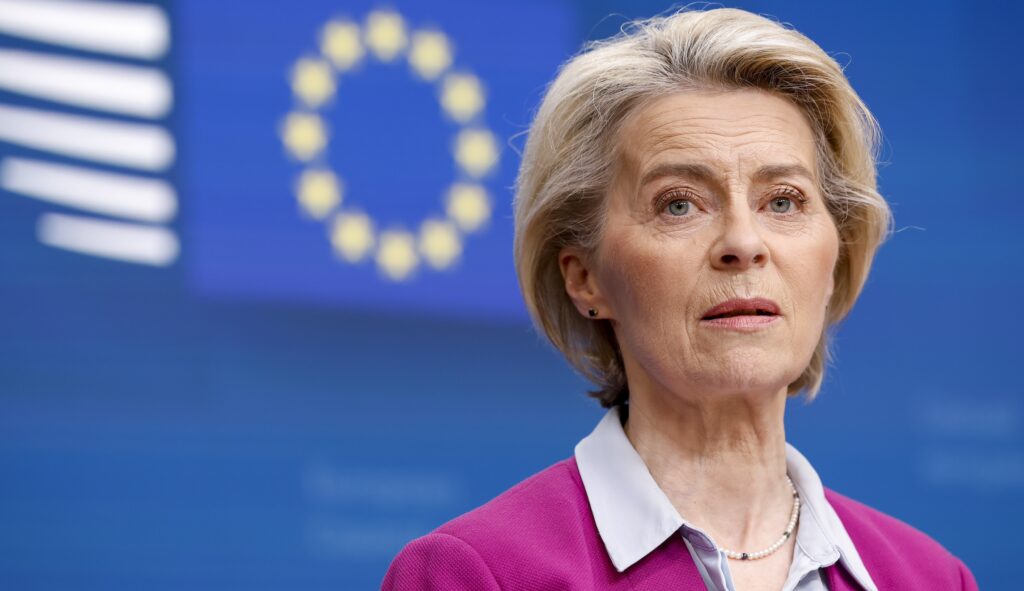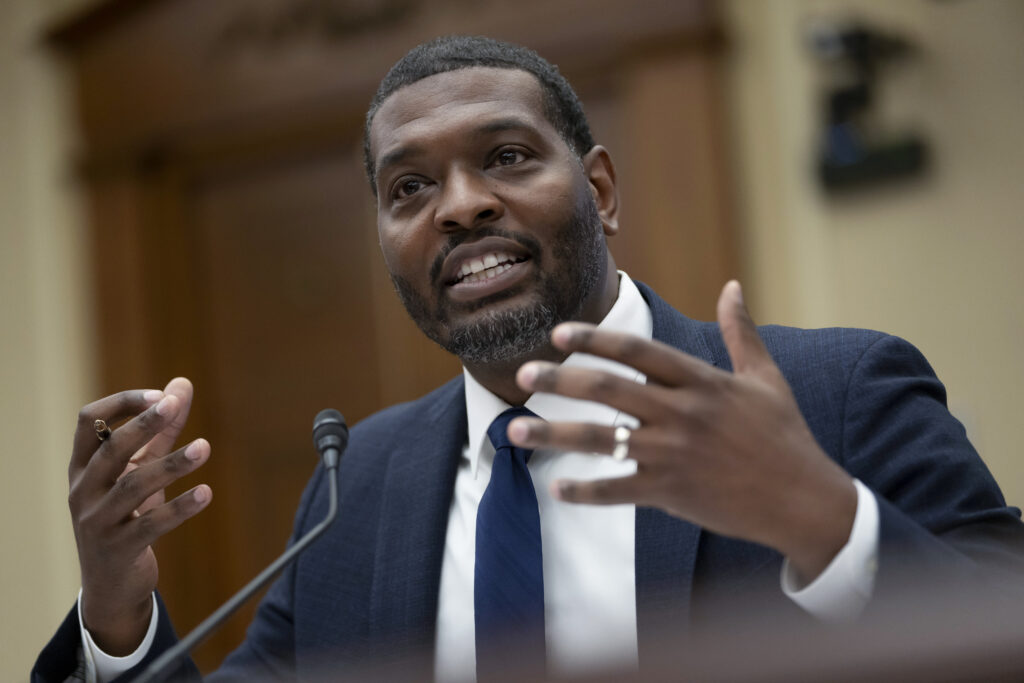Vice President Kamala Harris endorsed liberal positions on climate and energy before joining the Democratic ticket with President Joe Biden in 2020, stances that will now receive much greater scrutiny as she pursues the presidency with Biden’s endorsement.
While her stances on energy have closely aligned with Biden during their first term, her past record on fossil fuels and climate is to the left of Biden’s positioning and could serve as a hurdle to wooing fossil fuel-friendly swing states that could determine the November elections.
During her 2019 presidential run, Harris called for a ban on fracking, and was one of the original sponsors of the Green New Deal resolution – positions that could come back to bite her in, for instance, the battleground state of Pennsylvania, where natural gas production is a major industry.
Energy and inflation are topics that were expected to have significance heading into November – but will play an even greater role now that the Democratic ticket has undergone upheaval.
On a grand scale, Harris has worked with Biden to enact provisions of the 2021 bipartisan infrastructure law and the 2022 Inflation Reduction Act passed by Democrats, which provided for unprecedented federal subsidies for clean energy technologies — hundreds of billions of dollars’ worth.
However, during her brief 2019 presidential run before joining the Biden ticket, Harris said during a CNN town hall that she was “in favor of banning fracking” – a position that she said after becoming Biden’s runningmate did not represent Biden’s platform. Biden ran on halting fracking on federal lands, which is a small subset of overall fracking. In office, the Biden administration has slowed leasing for drilling on federal lands, but has not ended it altogether.
On the campaign trail, Harris also committed to supporting a carbon tax, and called for the end of government subsidies for the fossil fuels industry. Harris’ plan specifically called for the federal government to pass a bill she proposed with Rep. Alexandria Ocasio-Cortez (D-NY), the Climate Equity Act, which would require the government to consider the effects of any environmental legislation or regulation on low-income communities. She also vowed to ensure corporations to “appropriately assess and disclose risks from climate change.”
Her 2019 platform also outlines climate goals that were more aggressive than the current administration’s – seeking to create a clean energy economy by 2045, requiring new buses, heavy duty vehicles and vehicle fleets to be zero-emission by 2030 and all vehicles to be 100% zero-emission by 2035.
Harris also stated that she would utilize the Antiquities Act – a law that allows for the president the authority to create national monuments from federal lands – to protect 30% of the nation’s lands by 2030. She also vowed to phase out fossil fuel development on public lands and implement policies that would allow for the lands to be net carbon sinks by 2030.
During her time in the Senate, Harris was one of the original co-sponsors of a Green New Deal resolution – a measure that would call for the federal government to divest from fossil fuels and curb greenhouse gas emissions across the economy. It also promoted for boosting jobs in clean energy industries, investing in infrastructure, securing clean air and water, and “promoting justice and equality.” The resolution, though, was merely a messaging measure and would not have changed law.
Biden, in contrast, distanced himself from the Green New Deal. During his first presidential debate, Biden explicitly stated that the Green New Deal “is not my plan.” Republicans have frequently used the Green New Deal to campaign against Democrats as promoting radical climate ideas.
During her own presidential campaign, Harris touted her work as an attorney general in California, stating that she “took on oil companies that were polluting our environment. She also launched an investigation into whether Exxon Mobil lied to the public and shareholders about its contributions to climate change, and worked on indictments against Plains All American Pipeline over a 2015 oil spill.
Several green groups came out in support of Biden’s decision to drop out of the race on Sunday, such as Evergreen Action, the League of Conservation Voters, and the Environmental Defense Fund.
“From establishing one of the first environmental justice units in the country when she was the district attorney of San Francisco, to taking on Big Oil in the courts as California Attorney General, to introducing visionary legislation including the Climate Equity Act and Clean School Bus Act in the Senate, Vice President Harris has fought to hold polluters accountable and deliver for the hardest-hit communities her entire career,” Evergreen Action Executive Director Lena Moffitt said in a statement. “We are confident that she is ready to carry forward President Biden’s historic legacy and set a new high bar for climate ambition in America.”
CLICK HERE TO READ MORE FROM THE WASHINGTON EXAMINER
Although Harris could take more centrist stances in her campaign this time, her past positions could serve as fodder for Republican attacks as she looks to defeat former President Donald Trump – who favors greater fossil fuel production, has called climate change a “hoax,” and has said he will roll back many of the IRA’s provisions.
2024-07-22 11:37:00, http://s.wordpress.com/mshots/v1/https%3A%2F%2Fwww.washingtonexaminer.com%2Fpolicy%2Fenergy-and-environment%2F3093143%2Fharriss-record-on-climate-and-energy-the-green-new-deal-fracking-bans-and-more%2F?w=600&h=450, Vice President Kamala Harris endorsed liberal positions on climate and energy before joining the Democratic ticket with President Joe Biden in 2020, stances that will now receive much greater scrutiny as she pursues the presidency with Biden’s endorsement. While her stances on energy have closely aligned with Biden during their first term, her past record,
Vice President Kamala Harris endorsed liberal positions on climate and energy before joining the Democratic ticket with President Joe Biden in 2020, stances that will now receive much greater scrutiny as she pursues the presidency with Biden’s endorsement.
While her stances on energy have closely aligned with Biden during their first term, her past record on fossil fuels and climate is to the left of Biden’s positioning and could serve as a hurdle to wooing fossil fuel-friendly swing states that could determine the November elections.
During her 2019 presidential run, Harris called for a ban on fracking, and was one of the original sponsors of the Green New Deal resolution – positions that could come back to bite her in, for instance, the battleground state of Pennsylvania, where natural gas production is a major industry.
Energy and inflation are topics that were expected to have significance heading into November – but will play an even greater role now that the Democratic ticket has undergone upheaval.
On a grand scale, Harris has worked with Biden to enact provisions of the 2021 bipartisan infrastructure law and the 2022 Inflation Reduction Act passed by Democrats, which provided for unprecedented federal subsidies for clean energy technologies — hundreds of billions of dollars’ worth.
However, during her brief 2019 presidential run before joining the Biden ticket, Harris said during a CNN town hall that she was “in favor of banning fracking” – a position that she said after becoming Biden’s runningmate did not represent Biden’s platform. Biden ran on halting fracking on federal lands, which is a small subset of overall fracking. In office, the Biden administration has slowed leasing for drilling on federal lands, but has not ended it altogether.
On the campaign trail, Harris also committed to supporting a carbon tax, and called for the end of government subsidies for the fossil fuels industry. Harris’ plan specifically called for the federal government to pass a bill she proposed with Rep. Alexandria Ocasio-Cortez (D-NY), the Climate Equity Act, which would require the government to consider the effects of any environmental legislation or regulation on low-income communities. She also vowed to ensure corporations to “appropriately assess and disclose risks from climate change.”
Her 2019 platform also outlines climate goals that were more aggressive than the current administration’s – seeking to create a clean energy economy by 2045, requiring new buses, heavy duty vehicles and vehicle fleets to be zero-emission by 2030 and all vehicles to be 100% zero-emission by 2035.
Harris also stated that she would utilize the Antiquities Act – a law that allows for the president the authority to create national monuments from federal lands – to protect 30% of the nation’s lands by 2030. She also vowed to phase out fossil fuel development on public lands and implement policies that would allow for the lands to be net carbon sinks by 2030.
During her time in the Senate, Harris was one of the original co-sponsors of a Green New Deal resolution – a measure that would call for the federal government to divest from fossil fuels and curb greenhouse gas emissions across the economy. It also promoted for boosting jobs in clean energy industries, investing in infrastructure, securing clean air and water, and “promoting justice and equality.” The resolution, though, was merely a messaging measure and would not have changed law.
Biden, in contrast, distanced himself from the Green New Deal. During his first presidential debate, Biden explicitly stated that the Green New Deal “is not my plan.” Republicans have frequently used the Green New Deal to campaign against Democrats as promoting radical climate ideas.
During her own presidential campaign, Harris touted her work as an attorney general in California, stating that she “took on oil companies that were polluting our environment. She also launched an investigation into whether Exxon Mobil lied to the public and shareholders about its contributions to climate change, and worked on indictments against Plains All American Pipeline over a 2015 oil spill.
Several green groups came out in support of Biden’s decision to drop out of the race on Sunday, such as Evergreen Action, the League of Conservation Voters, and the Environmental Defense Fund.
“From establishing one of the first environmental justice units in the country when she was the district attorney of San Francisco, to taking on Big Oil in the courts as California Attorney General, to introducing visionary legislation including the Climate Equity Act and Clean School Bus Act in the Senate, Vice President Harris has fought to hold polluters accountable and deliver for the hardest-hit communities her entire career,” Evergreen Action Executive Director Lena Moffitt said in a statement. “We are confident that she is ready to carry forward President Biden’s historic legacy and set a new high bar for climate ambition in America.”
CLICK HERE TO READ MORE FROM THE WASHINGTON EXAMINER
Although Harris could take more centrist stances in her campaign this time, her past positions could serve as fodder for Republican attacks as she looks to defeat former President Donald Trump – who favors greater fossil fuel production, has called climate change a “hoax,” and has said he will roll back many of the IRA’s provisions.
, Vice President Kamala Harris endorsed liberal positions on climate and energy before joining the Democratic ticket with President Joe Biden in 2020, stances that will now receive much greater scrutiny as she pursues the presidency with Biden’s endorsement. While her stances on energy have closely aligned with Biden during their first term, her past record on fossil fuels and climate is to the left of Biden’s positioning and could serve as a hurdle to wooing fossil fuel-friendly swing states that could determine the November elections. During her 2019 presidential run, Harris called for a ban on fracking, and was one of the original sponsors of the Green New Deal resolution – positions that could come back to bite her in, for instance, the battleground state of Pennsylvania, where natural gas production is a major industry. Energy and inflation are topics that were expected to have significance heading into November – but will play an even greater role now that the Democratic ticket has undergone upheaval. On a grand scale, Harris has worked with Biden to enact provisions of the 2021 bipartisan infrastructure law and the 2022 Inflation Reduction Act passed by Democrats, which provided for unprecedented federal subsidies for clean energy technologies — hundreds of billions of dollars’ worth. However, during her brief 2019 presidential run before joining the Biden ticket, Harris said during a CNN town hall that she was “in favor of banning fracking” – a position that she said after becoming Biden’s runningmate did not represent Biden’s platform. Biden ran on halting fracking on federal lands, which is a small subset of overall fracking. In office, the Biden administration has slowed leasing for drilling on federal lands, but has not ended it altogether. On the campaign trail, Harris also committed to supporting a carbon tax, and called for the end of government subsidies for the fossil fuels industry. Harris’ plan specifically called for the federal government to pass a bill she proposed with Rep. Alexandria Ocasio-Cortez (D-NY), the Climate Equity Act, which would require the government to consider the effects of any environmental legislation or regulation on low-income communities. She also vowed to ensure corporations to “appropriately assess and disclose risks from climate change.” Her 2019 platform also outlines climate goals that were more aggressive than the current administration’s – seeking to create a clean energy economy by 2045, requiring new buses, heavy duty vehicles and vehicle fleets to be zero-emission by 2030 and all vehicles to be 100% zero-emission by 2035. Harris also stated that she would utilize the Antiquities Act – a law that allows for the president the authority to create national monuments from federal lands – to protect 30% of the nation’s lands by 2030. She also vowed to phase out fossil fuel development on public lands and implement policies that would allow for the lands to be net carbon sinks by 2030. During her time in the Senate, Harris was one of the original co-sponsors of a Green New Deal resolution – a measure that would call for the federal government to divest from fossil fuels and curb greenhouse gas emissions across the economy. It also promoted for boosting jobs in clean energy industries, investing in infrastructure, securing clean air and water, and “promoting justice and equality.” The resolution, though, was merely a messaging measure and would not have changed law. Biden, in contrast, distanced himself from the Green New Deal. During his first presidential debate, Biden explicitly stated that the Green New Deal “is not my plan.” Republicans have frequently used the Green New Deal to campaign against Democrats as promoting radical climate ideas. During her own presidential campaign, Harris touted her work as an attorney general in California, stating that she “took on oil companies that were polluting our environment. She also launched an investigation into whether Exxon Mobil lied to the public and shareholders about its contributions to climate change, and worked on indictments against Plains All American Pipeline over a 2015 oil spill. Several green groups came out in support of Biden’s decision to drop out of the race on Sunday, such as Evergreen Action, the League of Conservation Voters, and the Environmental Defense Fund. “From establishing one of the first environmental justice units in the country when she was the district attorney of San Francisco, to taking on Big Oil in the courts as California Attorney General, to introducing visionary legislation including the Climate Equity Act and Clean School Bus Act in the Senate, Vice President Harris has fought to hold polluters accountable and deliver for the hardest-hit communities her entire career,” Evergreen Action Executive Director Lena Moffitt said in a statement. “We are confident that she is ready to carry forward President Biden’s historic legacy and set a new high bar for climate ambition in America.” CLICK HERE TO READ MORE FROM THE WASHINGTON EXAMINER Although Harris could take more centrist stances in her campaign this time, her past positions could serve as fodder for Republican attacks as she looks to defeat former President Donald Trump – who favors greater fossil fuel production, has called climate change a “hoax,” and has said he will roll back many of the IRA’s provisions., ,  , https://www.washingtonexaminer.com/wp-content/uploads/2024/07/kamala-harris-biden-steps-down-1024×592.webp, Washington Examiner, Political News and Conservative Analysis About Congress, the President, and the Federal Government, https://www.washingtonexaminer.com/wp-content/uploads/2023/11/cropped-favicon-32×32.png, https://www.washingtonexaminer.com/feed/, Nancy Vu,
, https://www.washingtonexaminer.com/wp-content/uploads/2024/07/kamala-harris-biden-steps-down-1024×592.webp, Washington Examiner, Political News and Conservative Analysis About Congress, the President, and the Federal Government, https://www.washingtonexaminer.com/wp-content/uploads/2023/11/cropped-favicon-32×32.png, https://www.washingtonexaminer.com/feed/, Nancy Vu,






